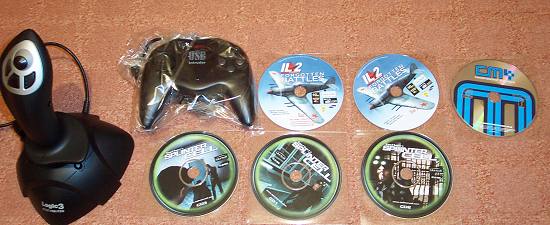MESH Inspection III
Other nicitiesA retail price of £1299 excluding VAT, in view of steady price drops that are occuring in the TFT sector, should push MESH towards providing a decent TFT screen with this gaming-orientated package. It does not disappoint. Viewsonic's VP181b 18.1" thin bezel (black, of course) provides the viewing thrills and spills.

The picture doesn't do the screen the justice that it deserves. 18.1" screen real estate is analagous to most 20" conventional CRTs'. Unfortunately for most users, resolutions haven't been stepped up in the same way as the laptop market, where 15" panels can, and often do, output to 1600x1200. The Viewsonic is 'limited' to a native 1280x1024 and loses focus if manually adjusted to a lower setting. Panel adjustment, physically, is excellent, with it turning 45 degrees in each direction. Portrait mode is available, as well as the ability to raise its position by up to 11cm from the lowest setting. Response time is quoted at a typical 30ms.
That kind of figure would normally condemn it to a non-gaming environment, however it proved to be every bit as good (or bad, depending upon on you see it) as a Samsung 181T. Indeed, the dragon's wings (in the dragothic portion of 3DMark 2001SE) exhibited far less response lag than the 181T's image. No, it's not as good as a decent CRT for gaming, especially with darker colours, but, subjectively speaking, it's good enough for brief periods of play. A contrast ratio of 350:1 and 250 nits cd/m2 put it at around the average level.
Where the panel excels is in reproduction of rich colours. White is so white that it literally slaps you in the face. Compared to the Samsung 181T, it produces far richer colours across the whole spectrum. The downside is that some images appear to be overexposed in parts. In fact, 2D imagery is more akin to a Sony CRTs than other TFTs I've previously tested.

This picture illustrates DVI usage (MESH provides the appropriate cable) and an in-built 4-port USB 2.0 hub. DVI is much-needed here. Image quality from an analogue source isn't as sharp or as clear as it should be. Another downside, if it can really be called that, is the comparatively poor viewing angle inherent to this panel. Look at it from, say, 150 degrees and the image loses focus and becomes dark. That, though, isn't really a problem in a home or office environment. At the target price point of £1299 it's certainly a value-adding component.
MESH provides a discrete Creative Audigy 2 ZS 7.1 sound card that's just above par for a PC in this pricing bracket. 7.1 infers support for an 8-speaker package, and that's exactly what's provided in the form of the aptly named Inspire 7.1-7100s. 2 of the 7 satellite speakers are shown in the TFT picture above. The front three speakers (one for the centre) are larger and more powerful than the four rear speakers, with a dual driver design. They can be wall-mounted and are controlled via the small remote control that covers volume and bass. It's also compatible with the MuVo-NX line of MP3 players (via the M-PORT interface).

Lots of inputs and outputs. The biggest problem is a logistical one. How do you house a total of 8 speakers on a desk or in a small room ?. Quality-wise, the front trio use separate drivers and tweeters to produce impressive sound for a sub-£100 package. The rears add in the ambience and effects for DVD films. Again, the combination of Audigy 2 ZS and Inspire 7.1-T7700 is above average specification for a £1299 power PC.
Software and setup

Windows XP Home Edition (version 2002 with SP1) is pre-loaded with all the requisite drivers in place. The PC booted first time and operated flawlessly in a week-long testing and usage session. Application and driver CDs for the motherboard, Nero Burning ROM, Audigy 2, Microsoft Works 7.0 (which wasn't pre-installed, strangely), and Pinnacle Studio 8 SE were included, along with the power and DVI cables.
There's no Windows XP Home Edition CD. Rather, MESH uses a multipurpose restore CD that is adept at performing system-related tasks, including recovering and restoring a default configuration. That leads me nicely on to the manual. It's written in an easy-to-understand fashion and provides concise, clear information on basic troubleshooting. The fold-out chart helps the user set the system up in the first instance.
One of the primary reasons for choosing a trusted system integrator over, say, a self-build is the extended warranty available from any self-respecting vendor. MESH provides a 3-year warranty on the E-JOY 3200+ that's split between on-site service for the first two years and return to base for the third. If the user experiences a problem that they cannot correct themselves, the first course of action is to contact MESH, either via an 0870 number or via e-mail, and it will evaluate if the system requires expert attention.

The games-orientated nature is further highlighted by what MESH calls its X-treme Games Bundle. Full editions of Championship Manager 4, Splinter Cell, and IL2: Forgotten Battles are included. A decent joystick and game pad are included to give it a more console-ish appeal. The games aren't some has-beens that are past their prime. We're genuinely impressed with their inclusion.
Noise
The MESH's CPU fan was perhaps the most irritating of the noise-making components. It's identical to the Evesham's. That means a shrill kind of sound that's only partially dampened by the thick steel exterior. What we need is the use of 80mm and 92mm fans that provide similar air throughput but do so with a lower RPM. Something along the lines of a Zalman 7000Cu, for instance.









